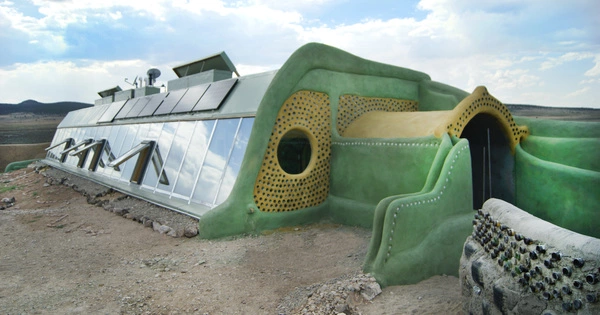An Earthship is a type of architecture developed by architect Michael Reynolds between the late twentieth and early twenty-first centuries. Earthships are passive solar earth shelters made of natural and upcycled materials such as earth-packed tires. Earthships can have a variety of amenities and aesthetics, and they are built to withstand the extreme temperatures of the desert, staying close to 70 °F (21 °C) regardless of outside weather conditions.
Michael Reynolds invented the Earthship, a type of sustainable, off-grid housing design. Earthships are self-sufficient and environmentally friendly structures made from recycled materials.
The key features of an Earthship include:
- Thermal mass: To provide thermal mass, earthships have thick walls made of rammed earth, tires packed with earth, or other dense materials. This aids in temperature regulation by absorbing heat during the day and releasing it at night.
- Passive solar design: Earthships are designed to maximize solar gain while reducing heat loss. Sunlight enters the building through large south-facing windows, and overhangs or shading devices help control the amount of solar heat gain.
- Rainwater harvesting: Earthships collect rainwater from the roof and direct it into cisterns for later use. This water is typically used for washing, bathing, and irrigation.
- Water recycling and treatment: Greywater (used water from sinks, showers, and washing machines) is treated and reused for flushing toilets or watering plants. Blackwater (sewage) is typically treated on-site using systems such as constructed wetlands.
- Renewable energy systems: To generate electricity, Earthships use renewable energy sources such as solar panels or wind turbines. Energy storage systems, such as batteries, are used to store excess energy for use during times of low generation.
- Food production: Earthships often include spaces for indoor or outdoor gardening, allowing residents to grow their own food. The thermal mass of the building helps regulate temperatures for optimal plant growth.
- Waste management: Earthships promote recycling and waste reduction. Organic waste is typically composted, and non-recyclable materials are minimized during construction.
Earthships aim to reduce reliance on external resources, minimize environmental impact, and provide sustainable and comfortable living spaces. They are typically designed to be “off-grid” and can function independently of municipal water, electricity, and sewage systems.
Earthship communities were first built in the desert of northern New Mexico, near the Rio Grande, and the style has spread to small pockets of communities all over the world, in some cases despite legal opposition to its construction and adoption.
















